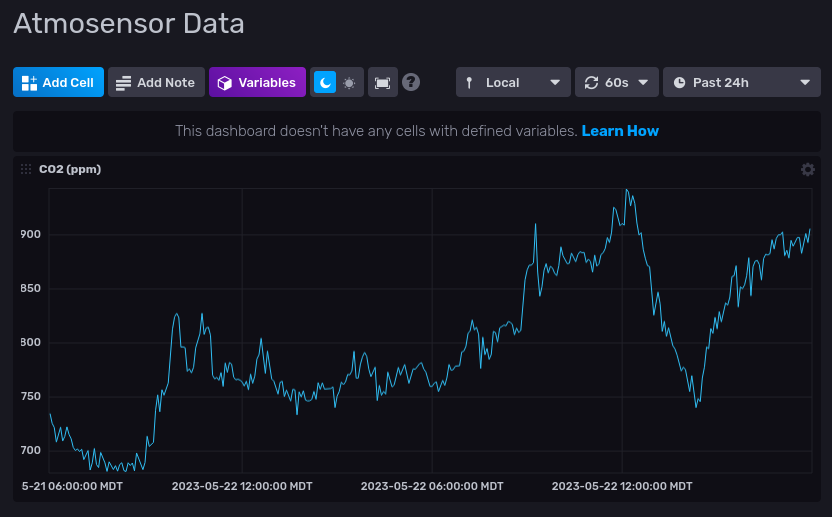Atmosensor MVP, and Going Forward
After several flurries of on-and-off development over the last several months, I actually managed to arrive at a minimum viable implementation for the main thrust of the Atmosensor project! It’s not pretty right now, but that’s also kind of the point!
Just as quick recap of what’s actually implemented so far:
- A schematic and PCB design for a board which queries data from a sensor over I2C and can be queried in turn over a USB serial port.
- A firmware in Rust that facilitates the above data transfer on the STM32 microcontroller.
- A client in Rust that runs on my home server, querying data and tucking it into a local InfluxDB instance.
- Various tools that support the development of the above.
The end result of all of the above is a dashboard with plots like this:

But! That does not mark the end of the project, at least in my mind. For one thing, I actually have more data that can be pulled from the SCD30 sensor that is measuring the CO2 concentration and I have a QWIIC connector on there which can connect the I2C bus to additional sensors. This project also isn’t about collecting the data for its own sake, it’d be nice to display this data in a more convenient form factor that an Influx dashboard in a way that can inform decisions like opening the windows and turning on fans.
In addition to all that, CO2 levels (and other data I can collect) are not actually a big worry for me. Part of the impetus for the atmosensor project was to build something I can continue to hack on over time and try out different ideas for structuring applications and to try out new types of software outside my wheelhouse entirely. The Influx dashboard looks nice, but it is a great opportunity to try out a less trivial Yew application which essentially does the same thing (though maybe safer to expose outside my network and not requiring authentication to my Influx server).
With that said, some projects I have more immediately in mind:
- Try a new version of the firmware that utilizes
freertos-rsbindings or even a Rust-based RTOS likedrone. - A Yew-based dashboard for displaying the data.
- I actually have all the parts to make my own version of these dot-matrix widget displays and it’d be cool to display my sensor data on there (maybe with a prompt to open a window).
- Break out parts of the
atmosensor-tuiinto a library which allows anyone who implements a trait or two to have a handy TUI of their own. This would also make it easier for me to implement a TUI which communicates with the already runningatmosensordapplication on my server to see what is being sent and received and allow me to remotely debug on my laptop. - I’d like to add a request ID to the serial protocol to make it possible to associate requests and responses over the wire.
- Dovetailing off the previous, I’d like to experiment with a nicer wrapper
over the
atmosensor-clientwith methods that can be awaited for a matching response, i.e.client.request_co2_data().awaitwhich would poll until a response with the CO2 data or an error is received. I’d could do a sloppy version of this now, but it needs request-response association to be done right. - I’d like to try out
tokio-tracingand log aggregation services. Currently all of my logs are just being printed out intostdoutwhich is not ideal if my server reboots and there was an important message in the output. - A mock implementation of the firmware device for testing application code against.
- I got stumped trying to get this to run in docker, something was wrong with USB communications specifically, so it’d be great to figure that out and do a proper deployment pipeline for updates via a container.
- A firmware bootloader application so I can deploy firmware updates remotely as well.
- Maybe try to write a set of python bindings for the
atmosensor-clientcrate withpyo3.
At my current rate, the above list ought to keep me busy until… 2030…? It’s a long list and there’s lot of interesting experiments on there to say the least. I’m hoping that as the implementation of these get to be less trivial and more specific that I can turn some of these into blogposts in their own right. We’ll see what the future holds!
If you notice a dead link or have some other correction to make, feel free to make an issue on GitHub!